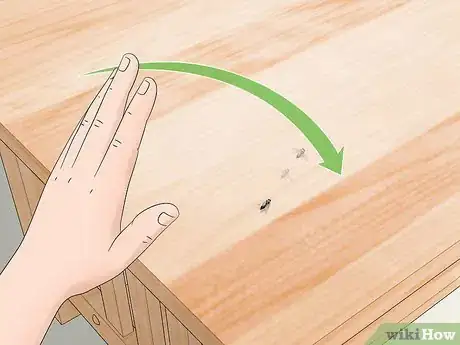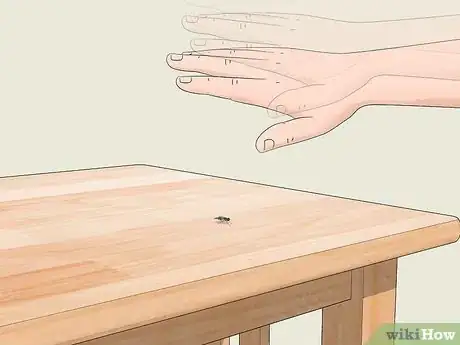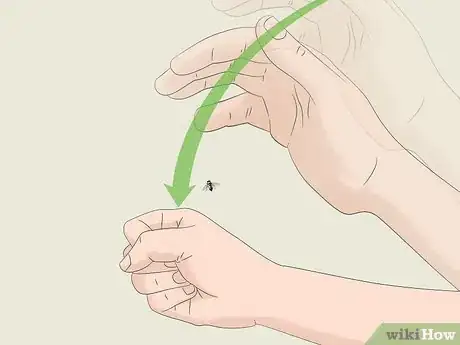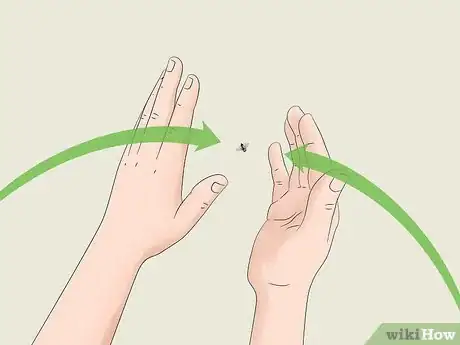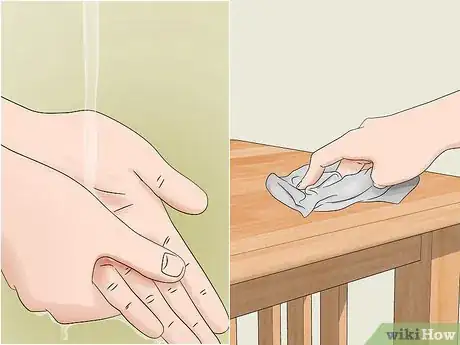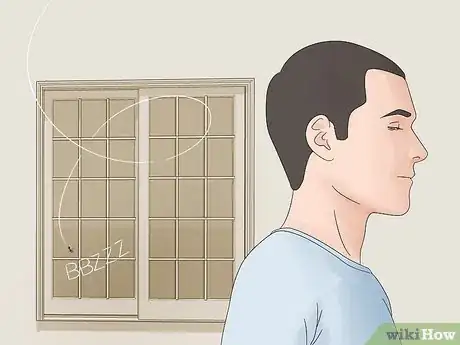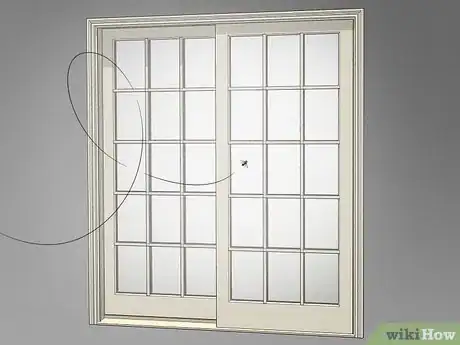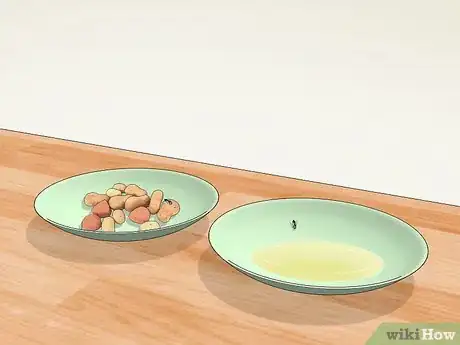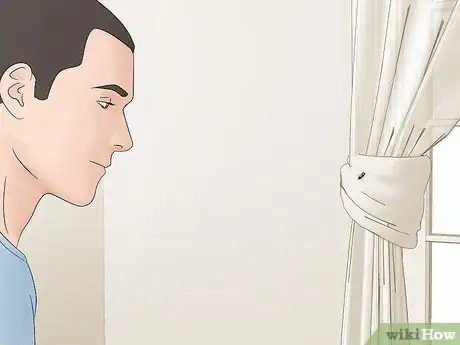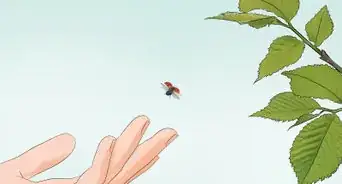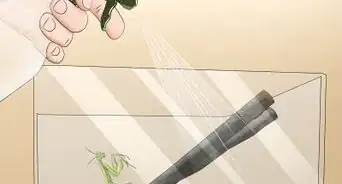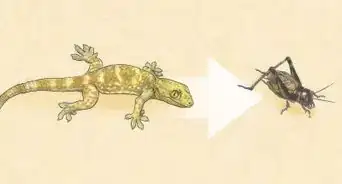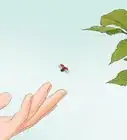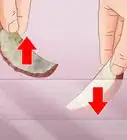This article was co-authored by Kevin Carrillo and by wikiHow staff writer, Amy Bobinger. Kevin Carrillo is a Pest Control Specialist and the Senior Project Manager for MMPC, a pest control service and certified Minority-owned Business Enterprise (MBE) based in the New York City area. MMPC is certified by the industry’s leading codes and practices, including the National Pest Management Association (NPMA), QualityPro, GreenPro, and The New York Pest Management Association (NYPMA). MMPC's work has been featured in CNN, NPR, and ABC News.
There are 12 references cited in this article, which can be found at the bottom of the page.
This article has been viewed 157,158 times.
Flies are the worst. It seems like no matter how many times you swat, they always get away! There's actually a good reason for that—flies can see nearly 360° around them, so it's almost impossible to sneak up on them.[1] Even if you get close, they're able to plan their escape route faster than you can blink.[2] Don't give up hope, though—and don't just swing blindly. Instead, take a methodical approach to finally catch that pesky fly for good.
Steps
Making Your Strike
-
1Move slowly toward the fly slowly once it lands. Because flies can quickly fly out of reach, it's easiest to catch one when it's sitting still. Wait for the fly to land on a flat surface, then ease towards it. Once the fly is in arm's reach, slowly move your hand so it's about 1–2 ft (0.30–0.61 m) away, then pause and plan your next move.[3]
- It's a good idea to let your hand hover in place for about 10-20 seconds to disarm the fly.[4]
-
2Aim slightly in front of the fly's path. Flies are able to rapidly adjust their take-off angle, which is a big part of why it's so hard to strike them directly. In fact, they can plan an escape in about 100 milliseconds—which is faster than the time it takes to blink. It's a little easier if you can anticipate which direction the fly will go, then try to intercept them.[5]
- For instance, if you're approaching the fly from the front, you know it will likely fly back to get away. In that case, you'd try to strike just a little behind where the fly is now.
Advertisement -
3Try to smash the fly against a hard surface to kill it. Get your hand as close to the fly as possible, with your palm open. Aim carefully at a little bit of an angle (remembering to account for the fly's escape route), then smack your hand down onto the surface that the fly is on. That should flatten the fly, getting rid of it for good!
- If the idea of smushing a fly with your bare hand grosses you out, this probably isn't the best option for you.
-
4Catch the fly as it takes off to capture it unharmed. Smashing a fly that's been bugging you for hours is certainly gratifying, but it's not for everyone. If you'd prefer a less lethal approach, place your cupped hand onto the surface that the fly is on. Then, sweep your hand forward, closing it into a fist as you reach the fly.[6]
- This will take some practice, but it's a pretty impressive trick if you can master it!
- Once you do this, simply open the door and release the fly outside. Just be sure not to let any more flies in when you do.
-
5Clap your hands to catch the fly mid-air. If the fly won't land, don't fret—you still may be able to catch it. Hold your hands up in the air, about 1 ft (0.30 m) apart. Follow the fly's path, and try to get close to where you think the fly will be. Once the fly gets close to you, move so your hands are on either side of it, then clap to smush the fly.
- If you don't want to kill the fly, keep your hands cupped when you clap them together. This will trap the fly in your hands, and you can easily release it outdoors.
- Some people also recommend clapping your hands just above the fly as it rests on a surface. The fly will see your hands moving from the sides and will fly upward, right into the path of your hands.[7]
-
6Move your hands back and forth to hypnotize the fly. Approach the fly slowly from the front, then hold your hands out about 1 ft (0.30 m) apart. Move your hands slowly from side to side as you get closer to the fly, until your hands are on either side of the fly. Then, quickly dart in with your dominant hand to grab the fly.[8]
- It's thought that the motion of your hands will confuse the fly as to what direction the threat is coming from, so it won't know where to go to escape.
-
7Wash your hands and sanitize any surfaces the fly was on. Flies are really gross. They feed on rotting food and feces, which means they're covered in nasty germs. They carry a lot of these germs on their feet, so every step they take can spread bacteria to the surfaces in your home. Any time you touch a fly, wash your hands thoroughly with soap and water. In addition, use a disinfectant cleaner to sanitize any of the surfaces in your home that the fly might have touched.[9]
- If you don't have soap and water available, use hand sanitizer until you're able to get to a sink.
Finding a Fly
-
1Listen for the buzz. Chances are, if you're trying to swat a fly, it's because you've heard it buzzing around until you couldn't stand it anymore. Use this to your advantage when you're tracking your target—if you lose sight of it, just stand still and close your eyes. Once you hear the direction the buzzing is coming from, you're that much closer to catching your foe.
- If you need to, turn off your TV or radio, along with any fans or appliances that might drown out the sound of the fly.
-
2Check near windows and lights. Flies are attracted to light, so if you're not able to see it right away, try checking near the brightest light source in the room. They also tend to get confused by windows, so check carefully on your windowsills and along the edges of your windowpanes. [10]
- You can try drawing the fly out by turning off all the lights in the room, then turning on one light source, like a lamp or a TV screen. Be sure to shut the blinds and drapes if it's light out.
-
3Put out bait for the fly if you still can't find it. Flies like really smelly food, but it's okay if you don't want to put out something rotten just to catch a single fly. Instead, try putting out something like a bit of a hamburger, a little pet food, or a splash of soda in a bowl. These things tend to attract flies, so it should come to check out the bait eventually.[11]
- Flies are especially attracted to honeydew melon, so if you have any on hand, slice some up and put it in a bowl![12]
-
4React calmly once you do see the fly. No matter how excited you are to finally spot your nemesis, don't just rush at the fly swinging as soon as you find it. Instead, be patient and methodical. Scientists believe that flies process information about 7 times faster than we do, which means that everything looks like it's in slow-motion to a fly. That's why it's so hard to just rush in and swat one.[13]
- Flies are excellent at spotting motion, but they're not as good at picking out shapes, so if you move slowly, they're less likely to see you as a threat.[14]
Expert Q&A
Did you know you can get expert answers for this article?
Unlock expert answers by supporting wikiHow
-
QuestionHow can I catch a fly that's trapped in my home?
 Kevin CarrilloKevin Carrillo is a Pest Control Specialist and the Senior Project Manager for MMPC, a pest control service and certified Minority-owned Business Enterprise (MBE) based in the New York City area. MMPC is certified by the industry’s leading codes and practices, including the National Pest Management Association (NPMA), QualityPro, GreenPro, and The New York Pest Management Association (NYPMA). MMPC's work has been featured in CNN, NPR, and ABC News.
Kevin CarrilloKevin Carrillo is a Pest Control Specialist and the Senior Project Manager for MMPC, a pest control service and certified Minority-owned Business Enterprise (MBE) based in the New York City area. MMPC is certified by the industry’s leading codes and practices, including the National Pest Management Association (NPMA), QualityPro, GreenPro, and The New York Pest Management Association (NYPMA). MMPC's work has been featured in CNN, NPR, and ABC News.
MMPC, Pest Control Specialist
References
- ↑ https://blog.nationalgeographic.org/2013/09/23/battle-ready-5-insects-prepared-for-war/
- ↑ https://www.sciencedaily.com/releases/2008/08/080828135901.htm
- ↑ https://www.wnypapers.com/news/article/current/2014/04/15/115762/hypnotizing-houseflies-lots-of-scuttlebutt
- ↑ https://www.bobvila.com/articles/how-to-get-rid-of-flies-in-the-house/
- ↑ https://www.sciencedaily.com/releases/2008/08/080828135901.htm
- ↑ https://www.theartofdoingstuff.com/the-art-of-catching-a-fly/
- ↑ https://www.independent.co.uk/news/science/why-are-mosquitoes-so-hard-swat-9765648.html
- ↑ https://www.wnypapers.com/news/article/current/2014/04/15/115762/hypnotizing-houseflies-lots-of-scuttlebutt
- ↑ https://www.sciencealert.com/houseflies-blowflies-carry-more-diseases-than-thought-bacteria-pathogens
- ↑ https://www.bobvila.com/articles/how-to-get-rid-of-flies-in-the-house/
- ↑ https://www.countryliving.com/home-maintenance/cleaning/a32858803/how-to-get-rid-house-flies/
- ↑ https://www.ncbi.nlm.nih.gov/pmc/articles/PMC4430494/
- ↑ https://www.independent.co.uk/news/science/q-why-it-so-hard-swat-housefly-it-sees-you-coming-slow-motion-8818124.html
- ↑ https://www.rentokil.ie/blog/how-to-swat-a-fly/

